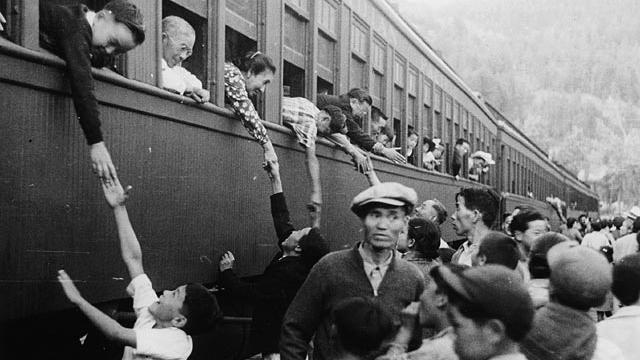Art Miki grew up on a modest berry farm outside Vancouver, British Columbia, in Canada, until 1942, when his family was forcibly relocated 1,400 miles away to Manitoba.
Miki, 86, has returned several times since then. The last time he visited the former family farm was 20 years ago.
“It was all boarded up, it was being taken over by a huge development,” he recalled. “That whole area is being developed.”
Today, the little riverside community of Haney is a bedroom community for Vancouver, one of the most-expensive cities in the world. Houses on a quarter of an acre routinely sell for more than a million dollars. But two generations ago, Miki’s family was paid $2,000 for its 14-acre farm.
They were among 22,000 Japanese Canadians that Canada relocated and incarcerated during World War II. Others were exiled to Japan, including some Canadian-born citizens who had never set foot there before.
The seizure of their properties cost them the chance to build generational wealth, something that Jordan Stanger-Ross, a historian at the University of Victoria, has studied.
Those property values increased between the 1940s and 1970s, some as much as 70-fold, he said.
Even if the families had been able to retain a small piece of their properties that were sold off, he said, “They would have inherited many times more [than] what they actually received.”
When the war broke out, there was a thriving community in downtown Vancouver. It was emptied out — “So, a neighborhood is erased,” he said.
A few organizations, like the Vancouver Japanese Language School, persisted. The school is still operating today. It even offers walking tours of the neighborhood, including one that goes through the Powell Street neighborhood. It’s now a run-down, semi-industrial part of east Vancouver, home to many of the city’s unsheltered people. It used to be lined with Japanese-owned businesses.
The owners were told their properties would just be held in trust by the government. But the government soon changed its mind, and put them up for sale.
Miki’s family was working on someone else’s beet farm outside of Winnipeg, Manitoba, when their own farm was sold out from under them, so that’s where he grew up.
Miki went on to become a teacher and lead the National Association of Japanese Canadians. In 1984, he announced the association was going to pursue reparations for the harm his community had suffered at the hands of the government. The government’s first offer? A $12-million community fund — take it or leave it.
“At that point, we walked away from the table,” Miki said. “And I remember, we all got together, and we decided to change our strategy. Meeting with the government, just our association, directly with the government, wasn’t working.”
The National Association of Japanese Canadians decided to make it a human rights issue. They gained the support of other Canadians — politicians, authors, academics, unions, churches and civil liberties organizations, he said.
But nobody knew exactly how much, exactly, had been taken from the community.
“They wanted some type of quantifiable number as to what our community lost, and you know, we couldn’t answer that question,” he said. “We didn’t have the data.”
Accounting firm PriceWaterhouse, which itself had been involved in the dispossession, agreed to take the analysis on — a first of its kind, according to historian Stanger-Ross. The firm analyzed the loss of employment and educational opportunities and the loss of the value of homes during the internment period. But it couldn’t really account for the loss of generational wealth.
“Just because the government now lifts the prohibition on their return to the coast, they still don’t own their home, they still don’t own their farm,” Stanger-Ross said. “They haven’t gotten their boat back, their automobiles and their personal possessions have not been returned.”
The PriceWaterhouse analysis was critical, though, in convincing the politicians that there was a real economic loss, Stanger-Ross said. It showed that a number — no matter how imperfect — could be put on that loss. Editorial boards of the major newspapers soon lined up behind the Japanese Canadians in their demands.
With growing support, the Japanese Canadians won the first apology the Canadian government had ever issued to a mistreated group, in 1988. Each survivor received $21,000, and a $12 million community fund was established.
Later, in the 2000s, apologies and redress would eventually come for Chinese Canadians subjected to a racist immigration tax; LGBTQ people who had been harmed by government policy; and Indigenous people who had gone through Canada’s genocidal Indian Residential School system.
“Those all followed after the Japanese Canadian redress, because that became a precedent that the government couldn’t ignore,” Miki said.
Joy Kogawa was in Parliament on Sept. 22, 1988, the day reparations were announced. She grew up interned in Alberta, far from her Vancouver home. She later wrote a nationally beloved novel about the internment.
Politicians, including New Democratic Party leader Ed Broadbent, read from her book, “Obasan,” in Parliament the day the government apologized.
“I was up in the galleries, and I looked down, and I saw [Broadbent] and I was just thunderstruck, you know, that he was doing this. It still fills me with the feeling of wonder that this happened.”
Today, Kogawa’s childhood home in Vancouver has been preserved as a space for writers. A poetry reading is held there one evening, a writers’ workshop the next.
Other spaces, like the Japanese Language School, or the Nikkei National Museum, are direct beneficiaries of the fund that was part of the negotiated redress. They’re places for learning, for sharing art and for fostering intercultural understanding — acts that were absent in the years of internment, when a whole group of Canadians were labeled enemies within the country.
